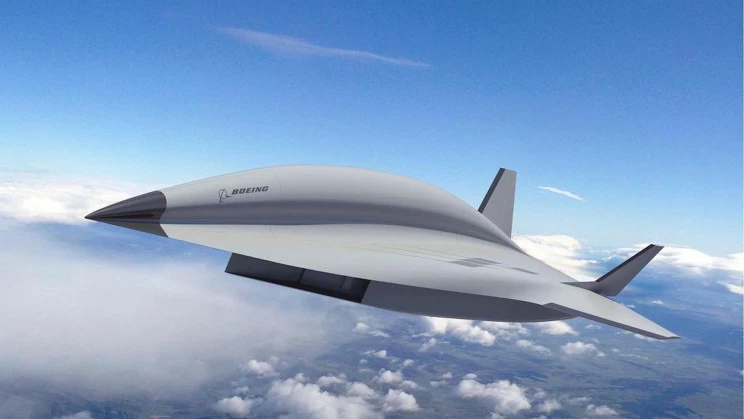
The new Boeing hypersonic aircraft concept could be a spiritual successor to the Mach 3 SR-71 Blackbird. At the AIAA SciTech aerospace forum, Boeing presented an artist’s rendering of the hypersonic aircraft concept delta-wing jet where it received a lot of attention.
Hypersonic Aircraft Concept Of The Future
In theory, this strike and reconnaissance hypersonic aircraft could fly at five times the speed of sound thanks to a “wave rider” design. This technology is pretty impressive as it would effectively employ the aircraft’s own shock waves produced during flight to boost lift while minimising drag.
Boeing has internally named the aircraft “Valkyrie II” but have yet to reveal anything substantial about its development. All we know is that the hypersonic aircraft would be an upgrade of an older concept called the Hypersonic Technology Vehicle 2 HTV-2.
While it did achieve a speed of Mach 20, “the vehicle experienced multiple system failures before crashing into the Pacific Ocean” as stated by Boeing Hypersonics’ technical fellow Kevin Bowcutt.
Around The World At Hypersonic Speed
The Valkyrie II seems to be the perfect evolution of the company’s original 2018 concept. It was slated a hypersonic passenger airliner that could travel between London and New York in just two hours. The hypersonic concept has been compared to Lockheed Martin’s SR-72 project, which is effectively the successor to the SR-71 Blackbird.
Jet designs from both Lockheed Martin and Boeing use a combined-cycle engine to reach Mach 3 before switching to a twin ramjet for hypersonic flight. Lockheed Martin has teamed up with Aerojet Rocketdyne to create an engine, while Boeing joined forces with Orbital ATK.
The “Son of Blackbird,” or SR-72, is a hypersonic aircraft designed by Lockheed Martin that could fly at Mach 6 (4,603 mph, 7.400 kph) which could make its inaugural test flight in 2025. The SR-71 Blackbird was, in fact, the world’s fastest crewed plane until it was phased out by the United States Air Force in 1998.
Hypersonic Aircraft And Missile Technology
The latest Hypersonic aircraft concept from Boeing is part of a new market that the company believes has the potential to become a launchpad for hypersonic aviation, where supersonic speeds are taken for granted.
So far, there have been no meaningful developments in the aviation industry regarding Hypersonic aircraft. Although there are Hypersonic missiles from various countries, Hypersonics as an everyday civilian transportation technology isn’t a reality at this point.
China’s hypersonic capabilities were recently in the news when they unveiled a hypersonic missile with “an advanced space capability” taking everyone by surprise. Meanwhile, in July 2017, the US Air Force gave a start-up, Hermeus, $60 million to build a prototype aircraft that can travel at Mach 5 speeds using a jet-powered wing.
Potential Applications Of Hypersonics
Considering hypersonic missiles are already in use by various countries, hypersonic aircraft could be ideal for military applications.
Hypersonics could take us from one side of the world to the other in a few short hours, replacing conventional long-distance passenger jets. However, it’s unlikely that hypersonic aircraft would be used for shorter flights as that speed is undesirable and unnecessary.
Hypersonic aircraft could also operate from smaller airports with shorter runways which would make air travel more efficient and accessible for everyone. Currently, civilians can’t use supersonic aircraft due to the high noise levels and restrictions.
Final Thoughts
Despite hypersonic research being largely defunct for decades, scientists haven’t stopped working on it. Aircraft development seems to have increased as everyone wants to travel faster and more sustainably; not to mention providing next-generation military capabilities.
While hypersonic aircraft and hypersonic missile technology seem to be a big talking point, we will have to wait and see if Boeing turns its new hypersonic aircraft prototype into the real thing. If successful, it could pave the way for future transport aircraft design.
For more interesting articles on technology, engineering and manufacturing, please read our blog as we work in several sectors, including automotive, aerospace, defence and rail.
SOURCES:
- www.citizenme.com/news
- www.interestingengineering.com


 Mail:
Mail: 



